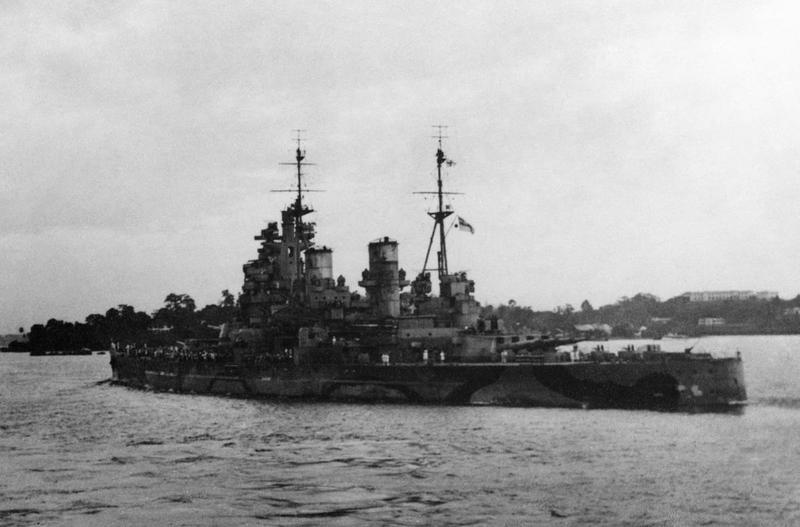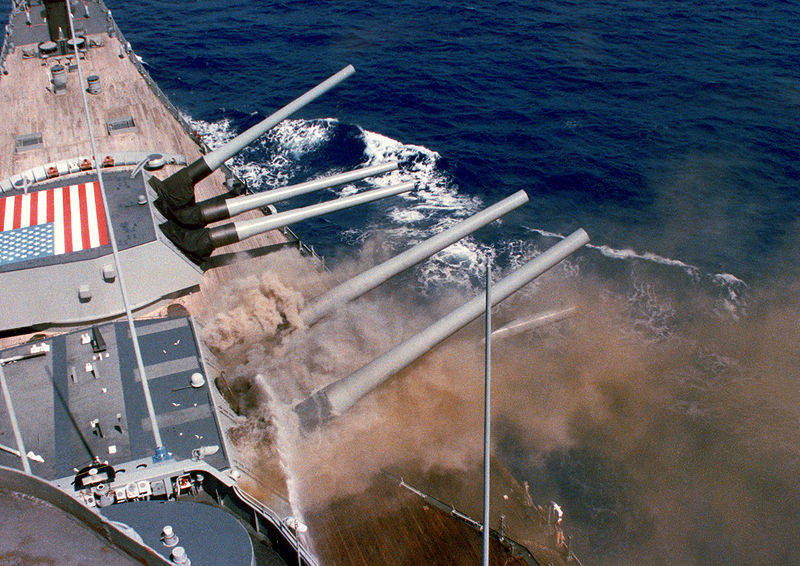Ran across a 2-part article, and thought I'd share it here. By a former Navy engineer, with lots of interesting bits on running a steam plant. Particularly valuable for his insights into reactivating old ships. I would quibble that there are still people who know how to run Iowa's plan and can make it down the ladder (I've done tours with a couple of them), but that's just nitpicking.
The Death of Repulse and Prince of Wales
Today marks the 76th anniversary of one of the most important days in the demise of the battleship. While the Pearl Harbor attack gets much more attention, the sinking of Force Z, the battleship Prince of Wales and the battlecruiser Repulse, at the hands of the Japanese was in many ways more influential. Both Pearl Harbor, and Taranto before it, were made on ships that were at anchor and unaware of the attackers. Force Z was at sea and alerted to the possibility of attack, a condition that many believed would keep it safe.

Prince of Wales in Singapore Harbor
Repulse and Prince of Wales were dispatched to Singapore by Churchill in October of 1941 in an attempt to deter the Japanese from starting a war.1 The two ships entered Singapore with four destroyers2 on December 2nd. They were greeted with a blaze of publicity unusual during the war. Read more...
The Loss of HMS Victoria
As I’ve been talking a lot about ironclads lately, I’m going to discuss one of the weirder episodes of the Victorian Royal Navy. In that era, the most important force in the RN was the Mediterranean Fleet. It was tasked with defending the vital link between Britain and the Empire East of Suez from the French and Russians, Britain’s most probable adversaries in the event of war. The newest and best ships were sent there, as well as the ones with low freeboard, as the Mediterranean is considerably calmer than the Atlantic.

Victoria firing her guns
HMS Victoria was commissioned in 1890, one of the last classic turret ships built. She carried two 16.25” guns in a twin turret, the largest guns ever to arm a British battleship.3 The guns were not successful. Slow-firing and inaccurate, they could only fire about 75 rounds before needing to be replaced.4 Victoria was sent to the Mediterranean shortly after commissioning, and in 1893, she was still one of the most highly thought-of ships in the RN. Vice-Admiral Sir George Tryon, commanding the Mediterranean Fleet, chose her as his flagship. Read more...
A Date Which Will Live in Infamy
Mr. Vice President, Mr. Speaker, members of the Senate and the House of Representatives: Yesterday, December 7th, 1941 — a date which will live in infamy — the United States of America was suddenly and deliberately attacked by naval and air forces of the Empire of Japan.

The United States was at peace with that nation, and, at the solicitation of Japan, was still in conversation with its Government and its Emperor looking toward the maintenance of peace in the Pacific. Indeed, one hour after Japanese air squadrons had commenced bombing in the American island of Oahu, the Japanese Ambassador to the United States and his colleague delivered to our Secretary of State a formal reply to a recent American message. And while this reply stated that it seemed useless to continue the existing diplomatic negotiations, it contained no threat or hint of war or of armed attack.
Ironclads
The history of the armored warship between 1860 and 1890 is very confusing, particularly due to the lack of consistent nomenclature. I've done what I can to simplify it, but this is going to be messy.5
The first armored warships were built during the Crimean War at the behest of Napoleon III. He wanted ten floating batteries to attack the Russian defenses in the Crimea and the Baltic, but French industry could only produce five. The British built the other five, although only the French ships went into action before the end of the war, taking part in the Battle of Kinburn, where three of them destroyed a Russian fort in a matter of hours with minimal casualties to themselves. They were slow and hard to maneuver, but gave British and French designers experience that would be valuable when they embarked on proper seagoing ironclads.6

The French Ironclad Gloire
The first of these ships was the French ironclad Gloire, launched in 1859. She was wooden-hulled due to industrial limitations in France, and ultimately was a fairly conventional design.
An Anniversary
Two years ago today was my first day as a tour guide on the Iowa. I ended up tagging along on a tour for a gentleman who'd served aboard during the Korean war, and got to see some of the behind-the-scenes parts of the ship. We tried to find his berthing compartment, but had no luck due to the changes made in the 80s. It was a cool first day.
That evening was the San Pedro Boat Parade. This gave me my chance to climb inside the aft port 5" mount. They were going to fire it that evening, and I was younger and more flexible than the rest of the gun crew, so I was asked to elevate the guns. The pointer seat was pretty tight, even for me. I'm amazed they got 14 people in the mount in service.
USS Iowa (BB-61) Part 8 - Preservation
Decommissioning wasn't quite the end of the story for Iowa and her sisters. The Marines wanted to retain the vessels for fire support in a future war, while most of the rest of the Navy wanted to get rid of them to avoid paying for their ongoing maintenance, and various groups wanted to turn them into museums. In 1995, all four were struck from the Naval Vessel Register,7 opening the way for them to be donated as museums. Congress was not happy with this, and in the 1996 National Defense Authorization Act directed that two of the ships be retained by the Navy. Originally, New Jersey and Wisconsin were selected to be reinstated, but pressure from groups in the state of New Jersey lead Congress to mandate that Iowa and Wisconsin be maintained, and Iowa was placed back on the NVR in 1999.8

Iowa and Wisconsin at Philadelphia Naval Shipyard, 1993
Mine Warfare Part 2
While the first naval mines were contact mines and they are still the dominant type numerically, the main focus of mine warfare in recent decades has moved to influence mines, which are set off by means other than physical contact with a ship’s hull. Influence mines are traditionally laid on the bottom, although they can be moored if the water is too deep for bottom mines to be effective.

A German air-dropped magnetic mine
USS Iowa (BB-61) Part 7 - Turret II and Retirement
After five very successful years in service during her third commission, tragedy struck Iowa. On April 19th, 1989, she was conducting gunnery drills as part of FLEETEX 3-89, a training exercise with the navies of Brazil and Venezuela. At 9:55, while the center gun of Turret II was being loaded with the first round, the powder exploded, killing 47 men. This exact cause is still somewhat controversial, and the Navy's handling of the investigation did not help. I should emphasize at this point that everything which follows is my own opinion, and I don't speak for anyone else on this.

Smoke billows from Turret II after the explosion
In the immediate aftermath, the crew of the Iowa responded heroically, fighting to save the ship in what was still a very dangerous situation. The anti-flash measures, most notably the scuttles isolating the powder flat from the turret proper,9 worked well, and a repeat of the fate of the battlecruisers at Jutland was avoided. But there was still the risk of heat soaking into the powder flats and igniting the powder, so the magazines were flooded. It took about 90 minutes to extinguish the fire, and several members of the crew were decorated for their actions during this battle. Read more...
Russian Battleships Part 1
When he offered to host me, I offered Said Achmiz the opportunity for me to pick a topic to write on. He selected Russian battleships, and I found a really good deal on a copy of Stephen McLaughlin's Russian & Soviet Battleships, the standard source on the subject, so settle in for a tale, that like most tales from Russian history, began with bright hopes, and subsequently fell apart.10

Petr Velikii, the first Russian battleship

Recent Comments